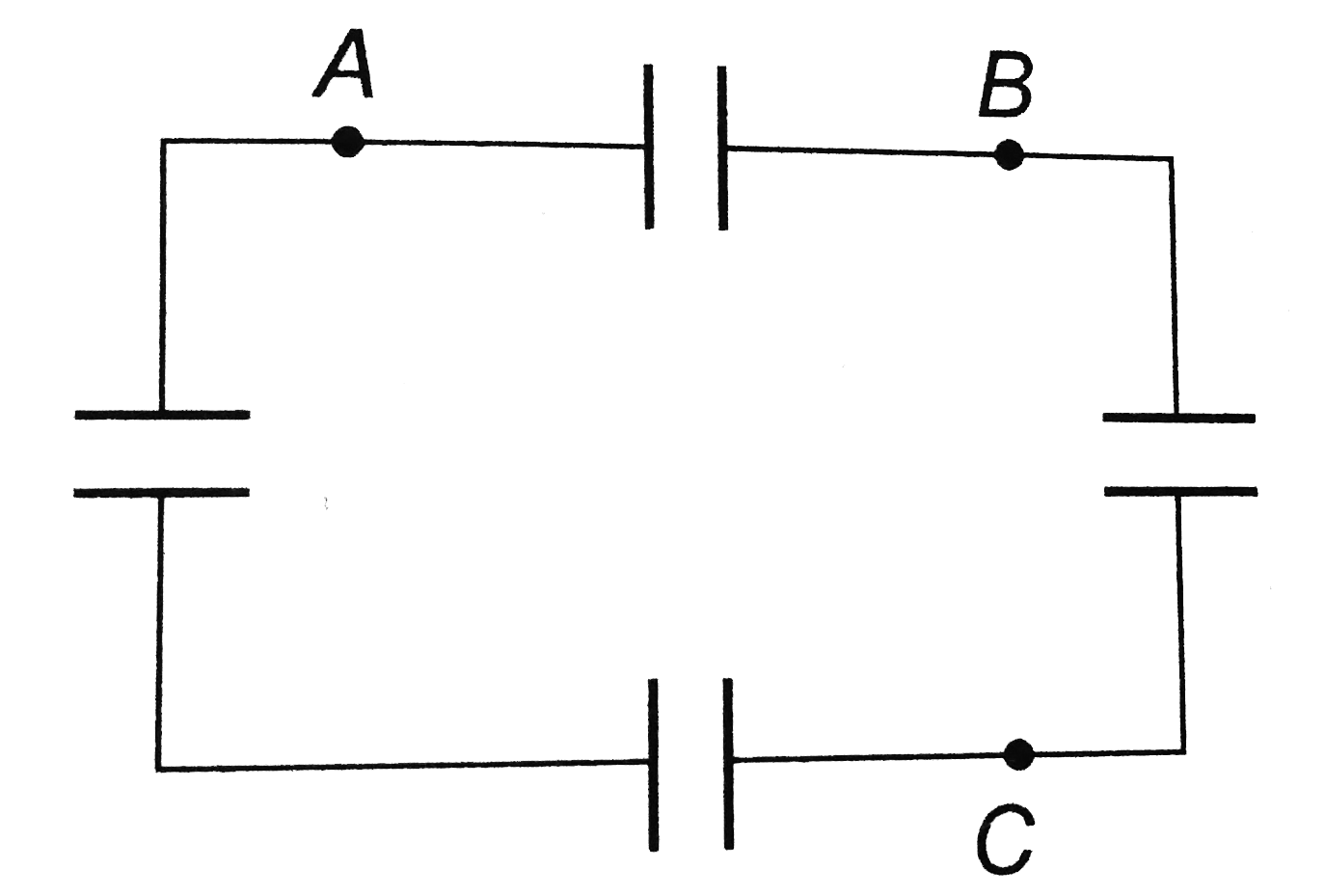Three capacitors each of capacity 4μF are to be connected in such a way that the effective capacitance is 6μF. This can be done by
connecting them in series
connecting them is parallel
connecting two in series and one in parallel
connecting two in parallel and one is series
The correct Answer is:C
To solve the problem of connecting three capacitors, each of capacity 4μF, to achieve an effective capacitance of 6μF, we can analyze the different configurations of connecting capacitors: series and parallel.
Step 1: Understanding Capacitor Connections
1. Series Connection: The formula for the equivalent capacitance Ceq of capacitors in series is given by:
1Ceq=1C1+1C2+1C3
For three capacitors of equal capacitance C:
Ceq=C3
Substituting C=4μF:
Ceq=43μF≈1.33μF
This is not equal to 6μF.
Step 2: Parallel Connection
2. Parallel Connection: The formula for the equivalent capacitance Ceq of capacitors in parallel is:
Ceq=C1+C2+C3
For three capacitors of equal capacitance C:
Ceq=3C
Substituting C=4μF:
Ceq=3×4=12μF
This is also not equal to 6μF.
Step 3: Combination of Series and Parallel
3. Combination of Two in Series and One in Parallel: Let's connect two capacitors in series and one capacitor in parallel with the combination.
- Two Capacitors in Series:
Cseries=C2=42=2μF
- Adding the Third Capacitor in Parallel:
Ceq=Cseries+Cparallel=2μF+4μF=6μF
This configuration gives us the desired effective capacitance of 6μF.
Conclusion
The effective capacitance of 6μF can be achieved by connecting two capacitors in series and one capacitor in parallel with the series combination.
1Ceq=1C1+1C2+1C3
For three capacitors of equal capacitance C:
Ceq=C3
Substituting C=4μF:
Ceq=43μF≈1.33μF
This is not equal to 6μF.
Ceq=C1+C2+C3
For three capacitors of equal capacitance C:
Ceq=3C
Substituting C=4μF:
Ceq=3×4=12μF
This is also not equal to 6μF.
Cseries=C2=42=2μF
- Adding the Third Capacitor in Parallel:
Ceq=Cseries+Cparallel=2μF+4μF=6μF
This configuration gives us the desired effective capacitance of 6μF.
Topper's Solved these Questions
- ELECTROSTATIC POTENTIAL AND CAPACITANCE BOOK - NCERT FINGERTPS ENGLISHCHAPTER - ELECTROSTATIC POTENTIAL AND CAPACITANCE EXERCISE - HOTS
5 Videos
- ELECTROSTATIC POTENTIAL AND CAPACITANCE BOOK - NCERT FINGERTPS ENGLISHCHAPTER - ELECTROSTATIC POTENTIAL AND CAPACITANCE EXERCISE - EXEMPLAR PROBLEMS
3 Videos
- ELECTROMAGNETIC WAVESBOOK - NCERT FINGERTPS ENGLISHCHAPTER - ELECTROMAGNETIC WAVESEXERCISE - Assertion And Reason
15 Videos
- MAGNETISM AND MATTER BOOK - NCERT FINGERTPS ENGLISHCHAPTER - MAGNETISM AND MATTER EXERCISE - NCERT Exemplar
5 Videos
Similar Questions
Seven capacitors each of capacitance 2μF are to be connected in a configuration to obtain an effective capacitance of (1011)μF. Which of the combination (s) shown in figure will achieve the desired result?
View SolutionSeven capacitors, each a of a cpacitance 2μF, are to be connected in a configuration to obatin an effective capacitance of (1613)μF. Which of the combinations, shown in figure below, will achieve the desired value ?
View SolutionThe effective capacitence in μF in between A and B will be

View SolutionSome capacitors each of capacitance 30μF are connected as shown in. Calculate the equivalent capacitance between terminals A and B
 .
.
View SolutionThree capacitors 2μF,3μFand6μF are joined with each other. What is the minimum effective capacitance?
View SolutionThree capacitors of capacitance 3μF are connected in a circuit. Then, their maximum and minimum capacitance will be
View SolutionFour capacitors each of capacity 8μF area connected with each other as shown in figure. The equivalent capacitance between points X and Y will be

View SolutionSix identical capacitors each of capacitance 2μF are connected as shown below. The equivalent capacitance between the points A and B is
View SolutionFour capacitors of each of capacity 3μF are connected as shown in the adjoining figure. The ratio of equivalent capacitance between A and B and between A and C will be

View SolutionSix equal capacitors each of capacitance 10μF are connect as shown in the figure. Then the equivalent capacitance between A and B is
View Solution


